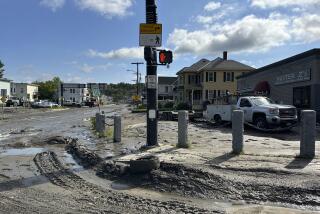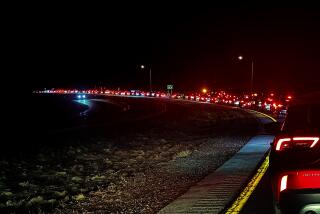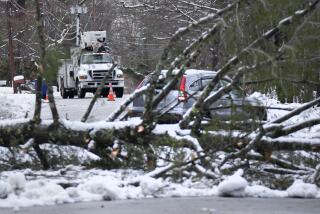Patience Running Low as Snowfall Hits High
BARNSTABLE, Mass. — Wearing four layers of clothing and boots intended for the Arctic, 6-foot-tall Richard Marshall stood atop a snow mound even taller than he is. He looked around in frustration, clutching his shovel. Everywhere he gazed was white and frozen.
“We’re running out of places to put this stuff,” Marshall, who works for the water department in this Cape Cod community, said last week. “You just have to shove the snow anywhere you can push it -- anywhere, just to get it off the road.”
A crushing blizzard and a steady series of smaller snowstorms have pushed January snow levels throughout New England to record numbers. At 42.2 inches, Boston last week set the record for monthly snowfall over the 113 years that such statistics have been kept.
The snow claimed lives. At least two people died from carbon monoxide poisoning after snow blocked pipes in their cars or homes. A Boston-area woman and her son who suffered carbon monoxide poisoning were being treated in a hyperbaric chamber at Massachusetts General Hospital; the woman’s daughter who was also being treated died Saturday.
Boston Globe columnist David Nyhan walked into his house after shoveling his walkway last weekend and died of a heart attack. A man who had recently emigrated from Honduras collapsed and died the same weekend outside City Hall in Chelsea, near Boston. His body was not discovered for two days.
Weekday snowfalls turned 45-minute commutes into three-hour ordeals. Huge snowdrifts at intersections also made driving perilous. State police said the surprise benefit was that traffic accidents were down from the previous month -- either because vehicles were traveling too slowly to cause much damage, or because so many people stayed off the roads.
In Boston, Mayor Thomas Menino backed off his threat to enforce a ban on the practice of “reserving” hand-shoveled street parking spaces with lawn chairs, cardboard boxes, old television sets and other cumbersome objects. The mayor said that with so much snow, he had bigger problems to worry about.
Most schools around Boston were closed much of last week, delighting students who could stay home and play in the snow but vexing parents who had to rearrange work schedules so they could watch their kids.
In many areas, the mail did not go through. Postal service supervisors left it up to individual carriers to determine whether it was safe to drive their trucks while storms were raging.
Services for the elderly and the housebound were strained. Homeless shelters, where occupants normally are permitted to stay only at night, adopted all-day schedules.
“It has been overflowing here,” said Shepley Metcalf, communications director at Boston’s Pine Street Inn, the largest homeless shelter in New England. “Every shelter bed is filled, plus we have close to 100 people sleeping on cots and mattresses on the floor.”
The task of clearing roads has devastated municipal budgets. The record snowfall exhausted the state’s $37.6-million annual allotment for snow and ice removal. Last week, Gov. Mitt Romney asked the Legislature for a $28-million supplemental to pay plow crews, who on most state roads have been working around the clock.
In a move that would enable the hardest-hit areas to receive federal assistance as they gird for more snow, the governor asked the White House to declare emergencies in 10 Massachusetts counties. The federal funds would reimburse towns for up to 75% of snow removal costs in any 48-hour period.
Barnstable County, which encompasses Cape Cod, was among those targeted by the governor. It was especially battered as snow continued well into Thursday evening -- several days after it had stopped, at least temporarily, in Boston.
About 25,000 homes on Cape Cod lost power at the height of the blizzard Jan. 23. That storm dropped more than 3 feet of snow on the Cape.
“It was terrible timing, right when the Patriots were getting ready to play,” Vanessa Lavoie, 25, said, referring to the New England football team that beat the Pittsburgh Steelers in the AFC championship. “We couldn’t even go watch the game at a bar, because the bars lost power too. We had to scramble around for batteries and listen on the radio.”
On Main Street in Hyannis, merchants carved out a slender sliver of sidewalk. But the snow wall between the street and the sidewalk was so high that one side of the street was invisible from the other. The entrances of establishments that were closed for the season, such as a Ben & Jerry’s ice cream parlor, were barricaded by piles of unshoveled snow.
Kris Shea said she spent hours digging out the front and back entrances to Nantucket Trading Co. so customers and deliveries could get through. The kitchen accessory shop on the busiest commercial street in Hyannis was closed for four days because of the snow, she said.
“I think if this snow had fallen gently, over the course of an entire winter, we could have handled it -- or handled it better,” said Shea, 37.
During the blizzard, Shea said, most people did not dare leave their homes, even when the power went out.
“What happens is, you have to talk to each other -- whether you want to or not,” she said. “When you are trapped together, it really is a test.”
Her co-worker Merrie Colby said many houses in her harbor-front neighborhood were sealed in snow and ice, like igloos.
“One house had an entire wall of sliding glass and picture windows covered with snow at least 4 feet wide and high,” she said.
Nearby, children turned 25-foot piles of snow in the Cape Cod Mall parking lot into sliding hills. Long rows of shopping carts outside a grocery store were buried in snow. A big hand-lettered sign outside a bargain emporium in Hyannis said: “WE HAVE ICE MELT” -- a welcome message, since many stores had sold out of the granular compound that helps melt snow and ice on driveways and sidewalks.
Still, Marshall, of the water department, and others on Cape Cod said the biggest problem was figuring out where to put all the snow plowed out of public spaces. State environmental officials reminded local authorities of a standing order against dumping snow into any body of water.
“That’s what we used to do, just haul it down to the beach,” Marshall said.
But the snow often contains contaminants, such as oil, gasoline and metals. Road sand housed in snow also can reduce oxygen levels in the water, potentially harming larvae and fish, environmental officials say.
Marshall said he had worked several consecutive 24-hour shifts, clearing roads and making sure that fire hydrants were not blocked. He said he worried about side roads in his town, where visibility was obscured by snow drifts up to 10 feet high.
Mindful that it was only January, Marshall said it made him dizzy to consider the prospect of even more snow.
“We might start trucking it out to some gravel pits, and we may put some in a couple of old parking lots,” he said. “Where to put it, that’s the problem.”
More to Read
Sign up for Essential California
The most important California stories and recommendations in your inbox every morning.
You may occasionally receive promotional content from the Los Angeles Times.










